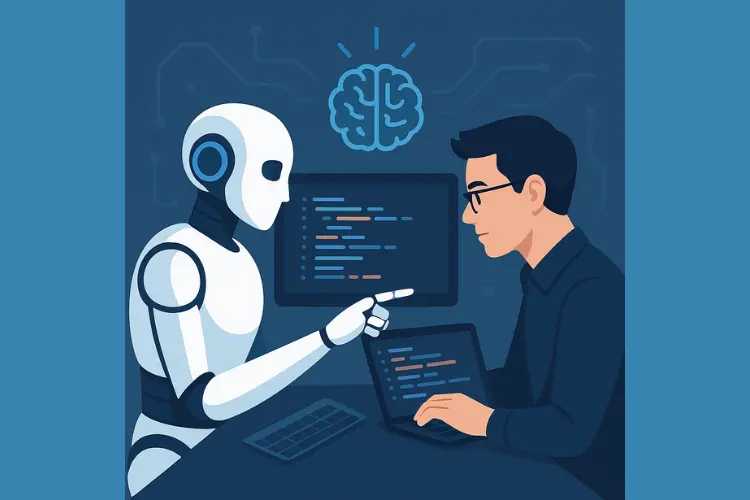Introduction
Artificial intelligence (AI) is transforming software development. Tools can now generate code, create test cases, and suggest optimizations in seconds. Companies see this as a way to cut costs and speed up delivery. But successful AI coding implementations still depend on experienced developers. Without human oversight, even the most advanced AI can produce flawed or insecure software.
This blog explains how to integrate AI effectively into development workflows. You will learn why human review is essential, how custom AI models improve results, and why developer education ensures long-term success.
The Power of AI in Coding
AI coding tools have advanced rapidly. Today, they can:
- Generate boilerplate code quickly.
- Suggest refactoring approaches for legacy systems.
- Create detailed documentation automatically.
- Produce unit and integration test cases.
These capabilities free developers from repetitive tasks. A fractional CTO in a growing startup, for example, can deploy AI tools to accelerate MVP development. The CTO can allocate senior engineers to high-impact features while AI handles routine coding. This approach shortens delivery times and improves team productivity.
Another advantage is AI’s ability to surface code patterns. By analyzing large codebases, AI tools can identify potential bugs and performance bottlenecks before they reach production. This predictive capability reduces costly post-release fixes.
The Limits of AI Without Human Oversight
AI excels at speed but struggles with context. Without human oversight, its output can contain:
- Security vulnerabilities.
- Inefficient algorithms.
- Misaligned business logic.
Developers must review, refactor, and integrate AI-generated code. They ensure compliance with security standards and maintain readability for future maintenance. A fractional CTO can establish review policies to catch issues early. This leadership role creates a balance between automation and accountability.
Consider an AI tool that generates a payment module for an e-commerce platform. Without expert review, it might miss local tax rules or compliance requirements. A developer with domain knowledge can spot these gaps immediately. This shows why AI is a partner, not a replacement.
Custom AI Models and Domain-Specific Knowledge
Generic AI models draw from vast, diverse datasets. While this makes them versatile, it also makes them prone to producing irrelevant or incorrect output in specialized fields. Custom AI models, on the other hand, use domain-specific data. This improves accuracy and relevance.
For instance, a healthcare startup can train a custom AI model on HIPAA-compliant code patterns. Developers then receive suggestions tailored to regulatory needs. A fractional CTO can oversee the development and integration of these models, ensuring they align with the company’s security and quality standards.
Domain expertise also matters. Even with custom models, developers must apply their knowledge to validate results. AI may generate technically correct code that fails business logic. Human oversight fills that gap.
Developer Education: The Key to Successful AI Integration
AI integration is not just about tools. It’s about people. Developers need training to work alongside AI effectively. This includes:
- Understanding AI’s strengths and weaknesses.
- Knowing how to review AI-generated code.
- Learning to prompt AI tools for better outputs.
A fractional CTO can design training programs that upskill teams. By investing in education, companies build a workforce capable of leveraging AI responsibly. This also improves morale. Developers who feel confident using AI see it as an enabler, not a threat.
Education also helps maintain ethical standards. Developers learn to handle data privacy, bias, and security issues in AI workflows. This ensures that automation does not compromise trust.
Integrating AI into Existing Development Processes
Integration works best when it complements existing processes. Businesses should start small and scale gradually. Here’s a step-by-step approach:
- Assess Needs: Identify tasks where AI can deliver the most value.
- Select Tools: Choose platforms compatible with your tech stack.
- Define Policies: Establish review and approval processes for AI-generated code.
- Train Teams: Provide hands-on training to developers and testers.
- Measure Outcomes: Track productivity, code quality, and cost savings.
A fractional CTO plays a pivotal role here. They align AI adoption with business goals and ensure compliance with security and regulatory standards. They also evaluate ROI, making sure investments in AI deliver measurable outcomes.
By following these steps, companies can integrate AI smoothly without disrupting workflows. This balanced approach protects quality and reduces risk.
Real-World Benefits of AI + Human Collaboration
Organizations that combine AI with human oversight see stronger results. Some benefits include:
- Faster release cycles.
- Fewer production defects.
- Improved documentation quality.
- Enhanced developer satisfaction.
For example, a SaaS company under a fractional CTO used AI to generate initial test cases. Developers then refined these tests to cover edge cases. The result was a 30% reduction in QA time and a noticeable drop in post-release issues.
Another startup used AI for automated documentation while developers focused on innovation. This not only improved internal knowledge sharing but also made onboarding new engineers easier.

Conclusion: AI as a Partner, Not a Replacement
AI is changing how we build software. It automates routine tasks and accelerates development. But its success depends on human expertise. Developers provide the oversight, domain knowledge, and ethical judgment AI lacks.
To harness AI’s full potential, businesses should invest in custom models, developer training, and clear integration policies. A fractional CTO can guide this transformation, ensuring AI delivers real business value without compromising quality.
At StartupHakk, we believe AI is a powerful partner when combined with skilled professionals. By following the principles outlined here, companies can innovate faster, reduce risk, and build software that truly meets user needs.




